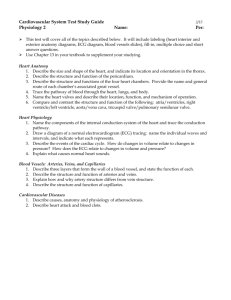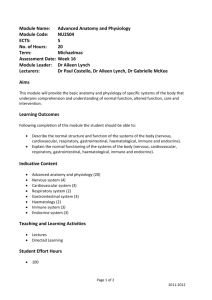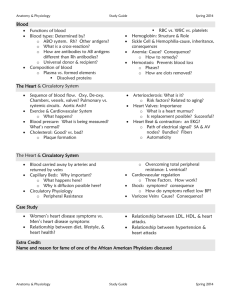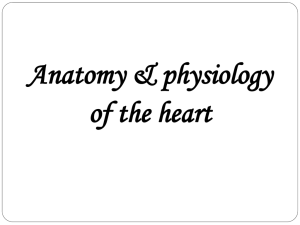Date Printed: 4-15-12 Weekly Lesson Plan View (by Day)
advertisement
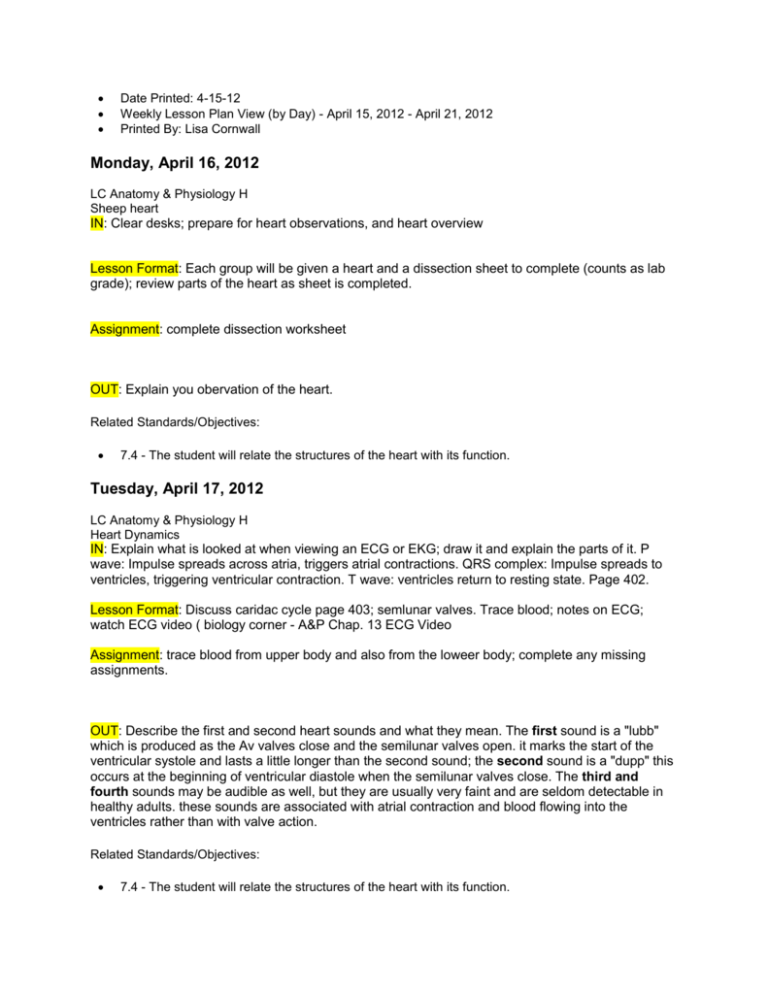
Date Printed: 4-15-12 Weekly Lesson Plan View (by Day) - April 15, 2012 - April 21, 2012 Printed By: Lisa Cornwall Monday, April 16, 2012 LC Anatomy & Physiology H Sheep heart IN: Clear desks; prepare for heart observations, and heart overview Lesson Format: Each group will be given a heart and a dissection sheet to complete (counts as lab grade); review parts of the heart as sheet is completed. Assignment: complete dissection worksheet OUT: Explain you obervation of the heart. Related Standards/Objectives: 7.4 - The student will relate the structures of the heart with its function. Tuesday, April 17, 2012 LC Anatomy & Physiology H Heart Dynamics IN: Explain what is looked at when viewing an ECG or EKG; draw it and explain the parts of it. P wave: Impulse spreads across atria, triggers atrial contractions. QRS complex: Impulse spreads to ventricles, triggering ventricular contraction. T wave: ventricles return to resting state. Page 402. Lesson Format: Discuss caridac cycle page 403; semlunar valves. Trace blood; notes on ECG; watch ECG video ( biology corner - A&P Chap. 13 ECG Video Assignment: trace blood from upper body and also from the loweer body; complete any missing assignments. OUT: Describe the first and second heart sounds and what they mean. The first sound is a "lubb" which is produced as the Av valves close and the semilunar valves open. it marks the start of the ventricular systole and lasts a little longer than the second sound; the second sound is a "dupp" this occurs at the beginning of ventricular diastole when the semilunar valves close. The third and fourth sounds may be audible as well, but they are usually very faint and are seldom detectable in healthy adults. these sounds are associated with atrial contraction and blood flowing into the ventricles rather than with valve action. Related Standards/Objectives: 7.4 - The student will relate the structures of the heart with its function. 7.5 - The student will discuss the physiology of blood pressure. Wednesday, April 18, 2012 LC Anatomy & Physiology H heart Dynamics/Blood pressure IN: Explain what makes up the cardiac output. Stroke Volume (ml/beat) X Heart rate (beats/min) = Cariac Output; Caridiac ouput provides an indication of the blood flow through perpheral tissues; without adequate blood flow, homestasis cannot be maintained. Lesson Format: Explain what to listen for to get some ones blood pressure; heart rate; use blood pressure machines to assist. (page 420); complete blood pressure lab Assignment: Complete blood pressure lab sheet OUT: Define a cardiac arrhytmmia. Abnormal patterns of caridac activity. Related Standards/Objectives: 7.7 - The student will discuss the mechanisms involved in the movement of materials within the peripheral circulatory system. [L.12.B.2] 7.4 - The student will relate the structures of the heart with its function. 7.5 - The student will discuss the physiology of blood pressure. Thursday, April 19, 2012 LC Anatomy & Physiology H Complete Blood pressure Lab IN: Name the age-related changes that may occur in the bloo. Page 444 1) decreased hematocrit(Percentage of whole blood contributed by cells 2)the constrixction or blockage of peripheral veins by the formation of a thrombus (stationay blood clot). Lesson Format:Complete Lab and complete overview of ciculatory system (Cardiovascular/blood); Watch How heart pumps animation ( Biologycorner - A&P chap. 13) Assignment: Complete lab and circulatory sheet OUT: The cardiovascular system is most closely related to what other system? Lymphatic system; not only are these 2 systems physically interconnected, but also cells of the lymphatic system use the cardiovascular systen as a highway to move from one part of the body to another. Related Standards/Objectives: 7.7 - The student will discuss the mechanisms involved in the movement of materials within the peripheral circulatory system. [L.12.B.2] Friday, April 20, 2012 CCSD - HS Testing Windows NAA Testing Window Ends LC Anatomy & Physiology H Introduction to Respiratory system IN: List the five basic functions of the respiratory system. 1) Providing a ;arge area for gas exchange between air and circulating blood. 2) Moving air to and from the gas-exchange surfaces of the lungs. 3) Protecting the respiratory surfaces from dehydration and temperature changes and defending against invading pathogens. 4) Producing sounds permitting speech, singing, and nonverbal auditory communication. 5) Providing olfactory sensations to the central nervous system for the sense of smell. Lesson Format: Begin notes on respiratory system. Assignment: Respiratory coloring and Chapter 15 vocab. OUT: Name the major anatomical structures of the respiratory system. nose - including the the nasal cavity and paranasal sinuses, pharnyx - throat, larynx - voice box, trachea - windpipe, bronchi, and the lungs, which contain the bronchioles - conducting passageways and the alveoli exchange surfaces. Related Standards/Objectives: 7.12 - The student will relate the major components of the respiratory system to their functions. [L.12.B.2]
